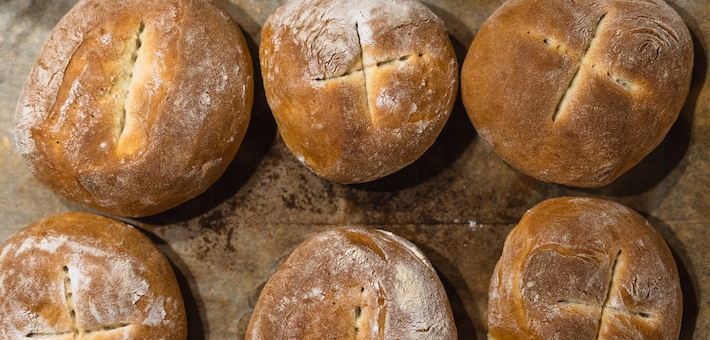Commentary on John 6:35-59
When clergy invite me to speak at their church, I ask them what they are wanting for their people. I’ve been struck lately by how many say some version of this: “My people are doing good work in the world, caring for those in need, deepening their knowledge of the faith. But some feel disconnected from God, spiritually dry. I want them to experience God, to feel nourished and restored.” I love watching clergy love their people.
If we are going to experience God, it will have to be in our bodies. This is, after all, the Gospel of Incarnation:
And the Word became flesh and tabernacled (skenoō) among us, and we have seen his glory, the glory as of a father’s only-begotten son, full of grace and truth. (1:14, my translation)
Thankfully, there has been increased interest among scholars recently in taking more seriously the senses, embodiment, affect, and imagination as relevant and even important in engaging Scripture and being transformed by it. John 6 is as embodied as it gets, even to the point of Jesus offending many (polus) of his disciples who promptly tap out (6:60-66). Ingesting Jesus (a phrase used by Jane Webster who has a book by that name), eating his flesh and drinking his blood makes us commingled with him, and therefore God, in the deepest way.
The passage begins with one of the seven predicated I Am statements that appear in John. There are two kinds of I AM statements in John: absolute and predicated. The absolute statements refer to Jesus adopting God’s own self-designation in the Old Testament. For instance, in Exodus 3 God appears to Moses in the burning bush to announce Moses’ role in the liberation of the Israelites. Moses asks God what he should say to the Israelites and God responds: “Thus you shall say to the Israelites, “I AM has sent me to you’” (3:14) Thus, when Jesus says, “Before Abraham was, I AM” (ego eimi, 8:58), the reader understands Jesus as God (see also, for example, 4:26, 6:20, 8:24, 8:28, 13:19, 18: 5, 6, 8). The predicated statements refer to the construction ego eimi + a predicate noun. There are seven of these in John:
- I am the bread of life (6:35, 41, 48, 51)
- I am the light of the world (8:12; 9:5)
- I am the gate of the sheepfold (10:7, 9)
- I am the good shepherd (10:11, 14)
- I am the resurrection and the life (11:25)
- I am the way, the truth, and the life (14:6)
- I am the true vine (15:1, 5)
Each of these proclamations invites us to explore how we are or could be connected to Jesus. Our passage, in fact, is the first predicated I Am statement in the Gospel and the only one repeated four times. The movement of the passage draws our attention to who Jesus is (Bread), how that benefits us (LIFE), and how we access what Jesus has to offer (believe; participate in the body of Christ).
- Jesus as Bread: Nourishment, Freedom, Virtue
Why does Jesus choose Bread for his first I Am saying? What does it mean? First, the context catalyzes the metaphor. Earlier in the chapter, at 6:1-15, Jesus takes 5 loaves of bread and multiplies it so that it feeds 5000 people. But that’s not all. The abundance is so profligate that even after all are fed, his disciples gather up 12 baskets of leftover bread. Over-the-top abundance is a theme of John (who surely was raised on Psalm 23 cups running over) where Jesus is said to have come that we might have life, and have it abundantly. The people needed bread to live another day. Jesus gave them bread and then used that connection to reveal something about himself as the one who can nourish them not only daily, but forever.
2. Moses and Exodus
John expressly sets Passover, connected with the feast of unleavened bread, as the context for Jesus giving bread and being bread. Passover celebrates Moses leading the Israelites out of slavery in Egypt. This explains why Jesus compares and contrasts himself with Moses (directly in the passage just before this and indirectly in our passage in verse 58), since Moses is also associated with a bread miracle, the manna from heaven. Jesus makes three distinctions, however:
- In verse 32 he notes that it was not ultimately Moses who provided the bread, but God. In Jesus’ case, he himself is the giver of the bread since he and God are one.
- The bread that the Israelites ate fed them daily; the bread Jesus gives provides eternal life.
- Jesus is both the giver of the bread that feeds them today and IS the bread that nourishes unto eternal life.
The feast of Passover and the comparisons with Moses recur in John in important ways. Passover is a story of freedom, of liberation. Famously, Jesus says in John 8:32: “If you (pl.) abide in my word (logos), you are truly my disciples; and you (pl.) will know the truth and the truth will set you free” [my translation].
3. The God Who Provides
In her wonderful book The God Who Provides: Images of Divine Nourishment, Juliana Claassens guides us through the Old Testament texts that depict God feeding and the profound implications that has for our theology and practices. It is important to note that feeding was a female role in antiquity, so such images depict God in feminine terms. In the New Testament Greco-Roman context, feeding and the inculcation of virtue were closely tied together and both were responsibilities of women.1 Jesus usually relates feeding people with spiritual formation (see also the meal with his disciples in chapter 13 and saying his food is doing the will of God in 4:34); when he does this, he assumes a female role of nourishing and moral formation. Think of the quintessential grandma: she makes you comfort food and teaches you how to behave. So does Jesus.
In sum, Jesus as Bread has many layers of meaning in John.
4. Eating to LIVE, not living to Eat
The best nutritionists tell you that you should eat to live, not live to eat. The loudest refrain by far in our passage is LIFE. Jesus causes us to truly live—abundantly, presently, and eternally. This Gospel is interested in nothing but us living to the max:
“But these are written so that you may come to believe that Jesus is the Messiah, the Son of God, and that through believing you may have life in his name” (20:31).
The words for life occur from beginning to end (1:3: “What has come into being in him was life, and the life was the light of all people”); in our passage alone life (zōē) appears seven times and live (zaō) occurs six times! Jesus is not just the bread; he is specifically the bread of life (verse 35), the living bread (verse 51) who makes us alive, now and forever. Who is this bread for? What is the scope of Jesus’ life-giving? The whole cosmos: “I am the living bread that came down from heaven. Whoever eats of this bread will live forever; and the bread that I will give for the life of the world (kosmos) is my flesh” (see also 3:16 and 1:3). And why not? After all, he helped create said world and is declared by the Samaritans to be Savior of the kosmos (4:42).
I wonder if we dream or expect too little sometimes. Jesus says LIFE for ALL and not just-enough life, but ABUNDANT life. 5000 fed, with leftovers. And at least one disciple, Mary of Bethany, shows us how it’s done: not just-enough nard but so much that the fragrance fills the room, ignoring the critiques of the joy-robbing, miserly Judases all the while! There’s life (pulse, heartbeat, brainwaves) and there’s LIFE; there’s living (punching the clock, going through the motions) and there’s LIVING.
5. Believe
How does a person get a hold of this life? Believe. Free of charge. All-inclusive. No suit and tie required. Starting now with no expiration date. Sounds like good news.
“Very truly, I tell you, whoever believes (pisteuō) has eternal life.”
6. You are what you eat: the eucharistic community
This Gospel takes flesh (sarx) and blood (haima) and the body (soma) very seriously, both Jesus’ and ours. Jesus helped create the world, including bodies. The Word became flesh. Bodies and flesh are the site of holiness, of revelation, of intimate love. In fact, “greater love has no one than this, than to lay down one’s life for one’s friends” (15:13). And that’s exactly what Jesus does. He refers to it in 6:51 where he reveals that the bread he will give is his flesh, referring to his death. We should be careful not to make the Platonic mistake of contrasting flesh and spirit and associating the flesh with evil or denigrating the material created order in any way, since God is the author.2 We experience God in the flesh. Our flesh is invigorated by the Spirit. Jesus, God, and the Spirit indwell us; we participate in them in our actual bodies. The mystics know this fully; the rest of us catch glimpses from time to time and it’s enough to remind us of eternity in a way that brings us back fully to being present to the present.
The eucharist can be such a site for some; for all of us, the eucharist (or communion, or the Lord’s Supper) reminds us we are part of a community, a community of life. Human beings were not made to be alone and cannot attain or maintain abundant life without others. We are in it together. Period. Notice that the “you” in our passage is plural, as is the case through most of John, even sometimes when Jesus is talking to an individual! The text was written out of an ancient community to invite others who would come behind them into community. May all who hear you preach taste and see that the Lord is good.
Notes
- For an extended treatment of this, see Alicia Myers’ Blessed Among Women?: Mothers and Motherhood in the New Testament (OUP, 2017).
- Refer to Dorothy Lee’s treatment of flesh in Flesh and Glory: Symbolism, Gender and Theology in the Gospel of John (Herder and Herder, 2002), 29-64.
PRAYER OF THE DAY
Holy and loving God,
Your son proclaimed living water to all who are thirsty. We are thirsty, Lord. Quench our thirst with your living water and heal our souls. Amen.
HYMNS
Jesus calls us; o’er the tumult ELW 696, H82 549, 550, UMH 398, NCH 171, 172
Spirit of the living God, fall afresh on me UMH 393, NCH 283
As the deer runs to the river ELW 331
CHORAL
Wade in the water, Moses Hogan


February 13, 2022